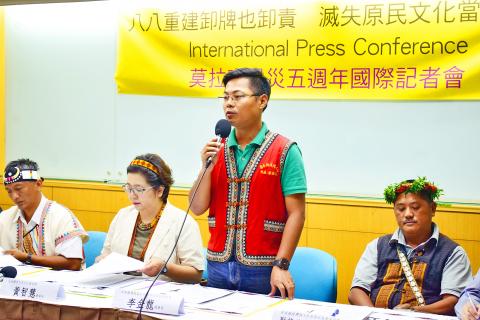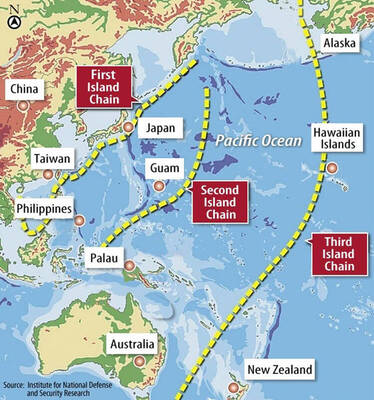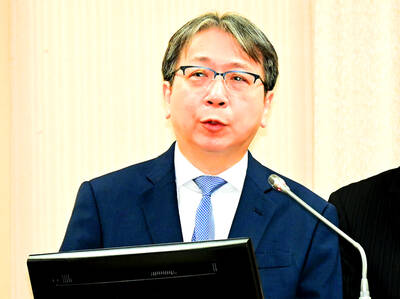As the government celebrates what it termed the “successful reconstruction” of areas devastated by Typhoon Morakot in 2009 and launched an exhibition highlighting reconstruction results, Morakot survivors yesterday accused the government of lying, saying that reconstruction is far from complete.
Morakot is considered the worst storm to hit the nation in 50 years; its massive mudslides caused almost 700 deaths, permanently changed the landscape and forced thousands of people to relocate.
Siaolin Village (小林) in what is now Jiasian Township (甲仙), Greater Kaohsiung, was completed buried by mudslides.

Photo: Courtesy of the Taiwan Association for Human Rights
While the government celebrates what it called the completion of reconstruction five years after the disaster, many survivors disagreed.
“When reconstruction efforts started, the government promised that people would not be relocated too far from where they originally lived, but it is a lie,” Huang Chih-huei (黃智慧), director of Millet Foundation of Indigenous Peoples, told a news conference in Taipei. “The government relocated Rukai residents of Ali Village (阿里) to a different township, forcing them to spend NT$500 per day on gas to drive to and from work on fields in their original village,” Huang said. “It is impossible for these villagers to farm as they used to.”
“In addition, each household has been moved to a house of 16 ping [52.8m2], where it is very difficult for a big family to live,” he said.
Lee Jin-long (李金龍), director of the Industrial Development Association for the Rukai Village of Kocapognan, agreed.
“Ali Village residents were evicted and relocated without their consent, despite the original village not being too seriously damaged,” Lee said. “Besides, the government never asked for their opinions before building the new village, making it a place with no connection to Rukai culture and tradition.”
Lee said that although they have houses, their lives have not been rebuilt, since their farmlands are far away.
Isnankan Dahay, a resident of the Bunun Aboriginal Village of Nansalu (南沙魯) in Namasiya District (那瑪夏), Kaohsiung, said that at the time, the government promised to allocate farmland to each household, “but it never happened.”
With no source of income, many villagers — himself included — moved back to the original village where they have farms, he said.
“The government said that Nanshalu wouldn’t be suitable for residents for at least 50 years,” Dahay said. “Well, I’ve been back for five years now and everything is fine.”
Taiwan Association for Human Rights Secretary-General Tsai Chi-hsun (蔡季勳) said that many people — especially Aborigines forced to relocate — are still struggling to rebuild their lives, but the government is not helping, but rather is creating obstacles for them.
“This is why we’ve always stressed the importance of information transparency and public participation in decisions,” Tsai said. “Otherwise, anyone could be forced to relocate or give up their lifestyle due to government decisions.”

The US government has signed defense cooperation agreements with Japan and the Philippines to boost the deterrence capabilities of countries in the first island chain, a report by the National Security Bureau (NSB) showed. The main countries on the first island chain include the two nations and Taiwan. The bureau is to present the report at a meeting of the legislature’s Foreign Affairs and National Defense Committee tomorrow. The US military has deployed Typhon missile systems to Japan’s Yamaguchi Prefecture and Zambales province in the Philippines during their joint military exercises. It has also installed NMESIS anti-ship systems in Japan’s Okinawa

‘WIN-WIN’: The Philippines, and central and eastern European countries are important potential drone cooperation partners, Minister of Foreign Affairs Lin Chia-lung said Minister of Foreign Affairs Lin Chia-lung (林佳龍) in an interview published yesterday confirmed that there are joint ventures between Taiwan and Poland in the drone industry. Lin made the remark in an exclusive interview with the Chinese-language Liberty Times (the Taipei Times’ sister paper). The government-backed Taiwan Excellence Drone International Business Opportunities Alliance and the Polish Chamber of Unmanned Systems on Wednesday last week signed a memorandum of understanding in Poland to develop a “non-China” supply chain for drones and work together on key technologies. Asked if Taiwan prioritized Poland among central and eastern European countries in drone collaboration, Lin

ON ALERT: Taiwan’s partners would issue warnings if China attempted to use Interpol to target Taiwanese, and the global body has mechanisms to prevent it, an official said China has stationed two to four people specializing in Taiwan affairs at its embassies in several democratic countries to monitor and harass Taiwanese, actions that the host nations would not tolerate, National Security Bureau (NSB) Director-General Tsai Ming-yen (蔡明彥) said yesterday. Tsai made the comments at a meeting of the legislature’s Foreign Affairs and National Defense Committee, which asked him and Minister of National Defense Wellington Koo (顧立雄) to report on potential conflicts in the Taiwan Strait and military preparedness. Democratic Progressive Party (DPP) Legislator Michelle Lin (林楚茵) expressed concern that Beijing has posted personnel from China’s Taiwan Affairs Office to its

BACK TO WORK? Prosecutors said they are considering filing an appeal, while the Hsinchu City Government said it has applied for Ann Kao’s reinstatement as mayor The High Court yesterday found suspended Hsinchu mayor Ann Kao (高虹安) not guilty of embezzling assistant fees, reducing her sentence to six months in prison commutable to a fine from seven years and four months. The verdict acquitted Kao of the corruption charge, but found her guilty of causing a public official to commit document forgery. The High Prosecutors’ Office said it is reviewing the ruling and considering whether to file an appeal. The Taipei District Court in July last year sentenced Kao to seven years and four months in prison, along with a four-year deprivation of civil rights, for contravening the Anti-Corruption